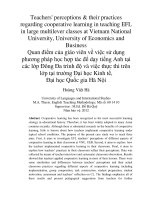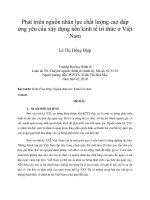Teachers' perceptions & their practices regarding cooperative learning in teaching EFL in large multilever classes at Vietnam National University, University of Economics and Business
Bạn đang xem bản rút gọn của tài liệu. Xem và tải ngay bản đầy đủ của tài liệu tại đây (153.96 KB, 12 trang )
Teachers' perceptions & their practices
regarding cooperative learning in teaching EFL
in large multilever classes at Vietnam National
University, University of Economics and
Business
Quan điểm của giáo viên về việc sử dụng
phương pháp học hợp tác để dạy tiếng Anh tại
các lớp Đông Đa trình độ và việc thực thi trên
lớp tại trường Đại học Kinh tế,
Đại học Quốc gia Hà Nội
Hoàng Việt Hà
University of Languages and International Studies
M.A. Thesis. English Teaching Methodology; Mã số: 60 14 10
Supervisor : M.Ed. Đỗ Bá Quý
Năm bảo vệ: 2012
Abstract. Cooperative learning has been recognized as the most successful learning
strategy in educational history. Therefore, it has been widely adopted in many Asian
countries recently. Although there is substantial research on the benefits of cooperative
learning, little is known about how teachers implement cooperative learning under
typical school conditions. The purpose of the present case study was to reach three
aims. First, it aims to investigate EFL teachers’ perceptions of different aspects of
cooperative learning in their classroom at VNU, UEB. Second, it aims to explore how
the teachers implemented cooperative learning in their classroom. Final, it aims to
explore how teachers’ practices in their classroom reflect their perceptions. Data was
collected by means of teacher interviews and systematic classroom observation. Results
showed that teachers applied cooperative learning in most of their lessons. There were
some similarities and differences between teachers’ perceptions and their actual
classroom practices regarding different aspects of cooperative learning including
implementation, group composition, task construction, student preparation, student
motivation, assessment and teachers’ reflection on CL. The findings emphasize all of
these results and present pedagogical suggestions from teachers for further
implementation of cooperative learning in their large multilevel classroom. In addition,
the researcher’s major recommendations are also listed out to enhance the effectiveness
of implementing cooperative learning in teaching English in large multilevel classes at
VNU UEB.
Keywords. Phương pháp giảng dạy; Giáo viên; Tiếng Anh
Content.
This initial part states the rationale for the study, the aims, the scope and methods of the
thesis. More importantly, the research questions are identified to work as clear
guidelines for the whole research. Lastly, this part concludes with an overview of the
rest of the thesis, serving as a compass to orientate the readers throughout the study.
The rest of the thesis includes four chapters
Chapter 1 (Literature review) provides the background of the study including
definitions of key concepts, aspects of cooperative learning, multilevel classes and
previous findings of cooperative learning.
Chapter 2 (Methodology) describes the aims, research questions, context, participants
and instruments of the study, as well as the procedures employed to carry out the
research.
Chapter 3 (Results of the study) presents all results collected from data from the
interviews and classroom observations
Chapter 4 (Discussion of the study): summarizes main findings, analyzes the findings,
and compares them with previous research to answer three research questions.
Conclusion summarizes the main issues discussed in the thesis, the findings that the
researcher found out from the data collected according to three research questions, the
limitations of the research, several pedagogical recommendations concerning the
research topic as well as some suggestions for further studies. Following this chapter
are bibliography and appendices.
Summary
In this chapter, the researcher has elaborated the following points:
1. Rationale
2. Aims of the study
3. Research questions
4. Scope of the study
5. Significance of the study
6. Methods of the study
7. An overview of the rest of the study
In brief, these elaborations have not only justified the major contents and structure of
the study but it also works as the guidelines for the rest of the thesis.
References.
Abrami, P. C., Chambers, B., D'apollonia, M. F., and Desimone, C. (1992)
Group
outcome: the relationship between group learning outcome, attributional style,
academic achievement and self-concept.
Contemporary Educational Psychology,
Abrami, P. C., Poulsen, C., and Chambers, B. (2004) Teacher Motivation to
Implement an Educational Innovation: Factors differentiating users and non-users of
cooperative learning. Educational Psychology, 24, 201-21
Aronson, E., Blaney, N., Sikes, J., Stephan, C., and Snapp, M. (1978) The
Jigsaw
classroom, Beverly Hills, CA: Sage.
Bandura, A. (1971). Social learning theory Upper Saddle River, NJ: Prentice Hall
Black, S. (1992). Group learning. Executive educator, 14 (9),18-20
Bennett, N., & Dunne, E. (1991). The nature and quality of talk in cooperative
classroom groups. Learning and Instruction, 1, 103-118.
Black, S. (1992). Group learning. Executive educator, 14(9), 18-20.
Blatchford, P., Kutnick, P., Baines, E., Galton, M.
(2003) Toward a social
pedagogy of classroom group work. International Journal of Educational Research,
Blatchford, P., Galton, M., Kutnick, P., Baines, E. Improving theEffectiveness of
Pupil Groups in Classrooms, ESRC End of Research
Report,
Biggs, J. B. (1995). What do inventories of students’ learning processes really measure?
A
theoretical review and clarification. British Journal of Educational Psychology,
Bill Gillham (2000).Case Study Reseach Methods. Beverly Hills, CA: Sage.
Bottery, M. (1990) The Morality of the School: the theory and practice of values in
education, London: Cassell.
Bruner, J. (1966). Toward a Theory of Instruction. Cambridge, MA: Harvard University
Press.
Chen, C. C., Chen, X. P., & Meindl, J. R. (1998). How can cooperation be fostered? The
cultural effects of individualism-collectivism. Academy of Management Review, 23, 285
Cohen, E . G. (1994a). Designing group work: Strategies for the heterogeneous
classroom (2
nd
ed.)New York: Teacher College Press.
Cohen, G. E. (1994). Restructuring the classroom: Conditions for productive small
groups. Review of Educational Research, 64(1). 1-35.
Cohen, E. G., Lotan, R. A., Abram, P. L., Scarloss, B. A., and Schultz, S.E.
(2002) Can Groups Learn? Teachers College Record, 104, 1045-2068.
Cottell, P. G., & Mills, B. J. (1992). Cooperative learning in accounting. Journal of
accounting
Education, 10, 95-111.
Earley, P. C. (1993). East meets West meets Mideast: Further explorations of
collectivistic and individualistic work groups. Academy of Management Journal,.
Earley, P. C. (1994). Self or group? Cultural effects of training on self-efficacy and
performance. Administrative Science Quarterly, 39, 89-117.
Dang-Thanh-Hung(2002). Modern teaching: Theories, Methodologies and
Techniques.(Day hoc hien dai: ly luan, bien phap, ky thuat). Hanoi: National
UniversityPublisher.
Dang-Thanh-Hung (2004). Design and use learning cards in Cooperative Learning
[Thiet ke va su dung phieu hoc tap trong day hoc hop tac], Education development
[Phat trien Giao duc],8-14.
Davidson, N., & Worsham, T. (1992). Hotsicle-Higher order thinking skills in
cooperative learning environments. In N. Davidson & T. Worsham (Eds.), Enhancing
thinking through cooperative learning (pp. xi-xx). New York: Teachers College Press.
Deutsch, M. (1962) Cooperation and Trust: Some theoretical notes. In Jones, M. R. (Ed.)
Nebraska symposium on motivation. (pp 275-319) Lincoln,
NE: University of
Nebraska Press.
Flick, U. (2006). Triangulation in qualitative research. In E. V. Kardorff, U. Flick, B.
Jenner & I.Steinke (Eds.), A companion to qualitative research (pp. 178-183). London:
Sage Publications.
Foyle, H. C., & Shafto, M. G. (1995). Teamwork in real world. In H. C. Foyle (Ed.),
Interactive learning in the higher education classroom (pp. 11-18). Washington, DC:
National Education Association.
Gay, L. R., Mills, E. G., & Airasian, P. (2006). Educational research: Competencies for
analysis and applications (8
th
ed.). Upper Saddle River, N.J.: Pearson Merrill Prentice
Hall.
Gibbs, G. (1992). Teaching more students 4: Assessing more students. Oxford: Oxford
Centre for Staff and Learning Development.
Gillies, R., and Ashman A. (1996) Teaching Collaborative Skills to primary
school
children in classroom based work groups. British Journal of
Educational
Psychology, 65, 211-25.
Gillies, R., & Ashman, A. (1998). Behaviour and interactions of children in cooperative
groups in lower and middle elementary grades. Journal of Educational Psychology, 90,
746-757.
Gillies, R., and Ashman A. (Eds.) (2003) Cooperative Learning: the social and
intellectual outcomes of learning in groups, London,RoutledgeFalmer.
Gillies, R. (2003). The effects of cooperative learning on junior high school students
during small group learning. Learning and Instruction,14, 197-213.
Gillies, R. (2008). Cooperative learning: Integrating theory and practice Thousand
Oaks, CA Sage Publications.
Good, T. L., & Brophy, J. E. (2000). Looking in classrooms (8
th
ed.). New York: Longman
Guba, E. G. (1978). Toward a methodology of naturalistic inquiry in educational
evaluation. Monograph 8. Los Angeles: UCLA Center for the Study of Evaluation
Harwood, D. (1989) The nature of teacher-pupil interaction in the active tutorial
work
approach: using interaction analysis to evaluate student-centred
approaches. British
Educational Research Journal, 15, 177-194.
Hertz-Lazarowitz, R. (1992) Cooperation and helping in the classroom: a
contextual approach. Journal of Educational Research, 13, 113-19.
Hofstede, G., & Hofstede, J. (2005). Cultures and organization-software of the minds (2
nd
ed.).New York, McGraw-Hill.
Huber, G., and Eppler, R.
(1990) Team learning in German Classrooms:
Processes and Outcomes. In Sharan, S. (Ed.) Cooperative Learning:
Theory and
Research. (pp. 15-172). New York: Praeger.
Jacobs, G. M., Power, M. A., & Loh, W. I. (1997). The teacher's sourcebook for
cooperative learning: Practical techniques, basic principles, and frequently asked
questions. Thousand Oaks, CA: Corwin Press.
Johnson, D. W., & Johnson, R. T. (1975). Learning together and alone. . Engle wood
Cliffs, NJ: Prentice-Hall.
Johnson, D. W., & Johnson, Roger. T. (1989). Approaches to implementing cooperative
learning in the social studies classroom. In R. J. Stahl & R. L. VanSickle (Eds.),
Cooperative learning in the social studies classroom: An invitation to social study (pp.
44-51). WA: National Council for the Social Studies.
Johnson, D. W., Johnson, R., & Smith, K. (1999). Cooperative learning returns to
college: What evidence is there that it works?
Johnson, D. W., Johnson, R. T., & Stanne, M. B. (2000). Cooperative learning methods:
A Meta Analysis Retrieved from on 20
April 2007.
Johnson, R. T., & Johnson, D. W. (2001).What’s Cooperative learning. The Cooperative
learning centre at the University of Minnesota Retrieved from on
26 November 2001
Johnson, D. W., Johnson, R. T., Holubec, E. J., & Roy, P. (2002). Circles of learning:
Cooperation in the classroom. Alexandria, VA: Association for Supervision and
Curriculum Development.
Kluger & DeNisi. (1996). Lifelong learning in Singapore: Where are we now? International
of Lifelong Education, 23(6), 559-568.
Krashen, Stephen D. Principles and Practice in Second Language Acquisition.
Prentice-Hall International, 1987.
Kutnick, P., Blatchford, P., & Baines, E. (2005). Grouping of pupils in secondary school
classrooms: possible links between pedagogy and learning Social psychology of
education.
Law, K. H. T. (2005). Relationships between conception and practice: A study of
teacher’s conceptions of teaching and classroom teaching practice related to
cooperative learning. (Unpublished doctoral dissertation). The University of Hong
Kong, Hong Kong.
Lou, Y., Abrami, P., and Spence J. (2000) Effects of within class grouping on student
achievement: an exploratory model. Journal of Educational Research, 94, 101-12.
Lou, Y., Abrami, P., Spence J., Poulsen, C., Chambers, B. and D'Apollania, S. (1996)
Within-class grouping: a meta-analysis. Review of Educational Research, 66, 423-58.
Manning, M. L., & Lucking, R. (1979). The what, why and how of cooperative
learning.The Social Studies. May/June, 120-124.
Mason, J. (2002). Qualitative researching (2
nyd
ed.). London: Sage Publications.
McDonough, J. and McDonough, S. (1997). Research Methods for English Language
Teachers. London: Arnold.
Messier, P. W. (2003). Traditional teaching strategies versus cooperative teaching
strategies:
Which can improve achievement scores in Chinese middle schools? Retrieved from
on 5 May 2007.
Michael Bassey (1999). Case study research in Educational Setting. London: Sage
Publications.
Morgan, D. L. (1998) Planning Focus Groups, Thousand Oaks, CA: Sage.
MOET (2004). Vietnamese higher education: Future plans. Retrieved from
on 4 September 2005
Natalie Hess,(2001). Teaching Large Multilevel Classes. Cambridge University Press
Nguyen-Huu-Chau (2005). Fundamental questions on teaching process.
[Nhung van de co ban ve chuong trinh va qua trinh day hoc]. Hanoi: Education
Publishing House- NXB Giao Duc.
Nystrand, M., Gamoran, A., and Heck, M. J. (1991) Small Groups in English:
When
do they help students and how are they best used? Madison WI: University of
Wisconsin-Madison, Centre on the Organization and
Restructuring of Schools.
Parlett, M., & Hamilton, D. (1976). Evaluation as illumination. In D. L. Tawney
(Ed.),Curriculum evaluation today. London: Macmillan.
Piaget, H., Pantuzzo, J. & Clement, P. (1986). The effects of reciprocal peer tutoring
and group contingencies on the academic performance of elementary school children.
Journal of Applied Behavior Analysis, 19, 93-98.
Phuong-Mai, N. (2008) Culture and Cooperation Cooperative Learning in Asian
Confucian heritage cultures: The case of Viet Nam. Netherlands: IVLOS Institute of
Education of Utrecht University.
Robert Yin (1994). Case Study Research: Design and Methods (2009)
Robyn M.Gillies and Michael Boyle (2009).Teachers’reflection on cooperative
learning : issues of implementation.Teaching and Teacher Education 26 (2010)
Ross, J. A., and Rolheiser, C. (2003) Student Assessment
Pica, T. (1994). Research on negotiation: what does it reveal about second language
learning, conditions, processes, outcomes? Language Learning, 44, 493-527.
Practices in Co-
Operative Learning. In R. Gillies, and Ashman A. (Ed.) Co-
Operative
Learning: The Social and Intellectual Outcomes of Learning in Groups.
(pp 119-135) London: Routledgefalmer.
Sama, L. M., & Papamarcos, S. D. (2000). Culture’s consequences for working women in
corporate America and Japan, Inc. Crosscultural Management: An International Journal,.
Sharan, S. (Ed. ) (1994). Handbook of cooperative learning methods. London:
Greenwood Press
Sharan, Y., & Sharan, S. (1990) Expanding cooperative learning through group
investigation. New York: Teachers College Press.
Silverman, D. (2000) Interpreting Qualitative Data, London: Sage.
Slavin, R. E. (1990). Cooperative learning: Theory, research and practice. Englewood
Cliffs, NJ: Prentice Hall.
Slavin, R. E. (1983a). Cooperative learning. New York: Longman.
Slavin, R. E. (1987). Cooperative learning and individualized instruction Arithmetic
Teacher.
Slavin, R. E. (1996). Research on cooperative learning and achievement: What we know,
what we need to know. Contemporary Educational Psychology
Slavin, R. E.(1995) Cooperative Learning: Theory, research, and practice,Boston:
Allyn and Bacon.
Slavin, R. E.(1999) Comprehensive Approaches to Cooperative Learning.Theory into
Practice, 38, 74-80.
Slavin, R. E., Madden, N.A., Karvweit, N.L., Dolan, L., Wasik, B.A., Ross, .M.,and
Smith, L.J.
(1994) Whenever and Wherever We Choose .The
Replication Of Success
For All. Phi Delta Kappan, 78, 639-647.
Sternberg,& Grigorenko. (2006) Schools and Religions, London: Continuum
Swain, M. (1995) Three functions of output in second language learning. In G. Cook &
B. Seidlhofer (eds), Principles and practice in the study of language . Oxford: Oxford
University Press.
Swing, S. A., Peterson, P. (1982) The Relationship Of Student Ability and
Small-
Group Interaction To Student Achievement. American Educational Research Journal, 19,
259-274.
Thanh-Pham, T. H. (2008). The roles of teachers in implementing educational
innovation: The case of implementing cooperative learning in Vietnam Asian Social
Science
Thanh-Pham, T. H, Gillies, R., & Renshaw, P. (2009). Cooperative learning (CL) and
academic achievement of Asian students: A true story. International Education Studies
Tice, J. (1997). Mixed ability classes. London: Richmond Publishing
Tran, H. Q. (2000). The policy-making context and policies of education and training in
Vietnam. Indochina Unit, Institute of Southeast Asian Studies.
Triandis, H. C. (1995). Individualism and collectivism. Boulder, CO: Westviews.
Tudge, J. (1990) Vygotsky: The Zone of Proximal Development and Peer
Collaboration: Implications for Classroom Practice. New York:
ColumbiaUniversity Press.
Ur, P. 1996. A Course in Language Teaching: Theory and Practice. Great Britain:
Cambridge University Press.
Virginia Braun & Victoria Clarke, (2006),Using thematic analysis in Psychology.
Cambridge University Press.
Vygotsky, L. (1978). Mind in society: The development of higher psychological
processes. Cambridge, MA: Harvard University Press.
Webb, R., and Vulliamy, G. (2009) Coming Full Circle? The Impact of New
Labour's Education Policies on Primary School Teachers' Work. London, the Association
of Teachers and Lecturers.
Wells, G., Chang, G.L. and Maher, A. (1990) Creating Classroom Communities of
Literate Thinkers. In Sharan, S. (Ed.) Co-operative Learning. (pp 23-37). New York:
Praeger.
Young-Ihm, K. (2002). Western influences in Korean preschools. International Education
Journal, 3(3), 12-19.
Zakaria, E., & Iksan, Z. (2007). Promoting cooperative learning in sciences and
mathematics
education: A Malaysian perspective. Eurasia Journal of Mathematics, Science
andTechnology Education, 3(1), 35-39.









